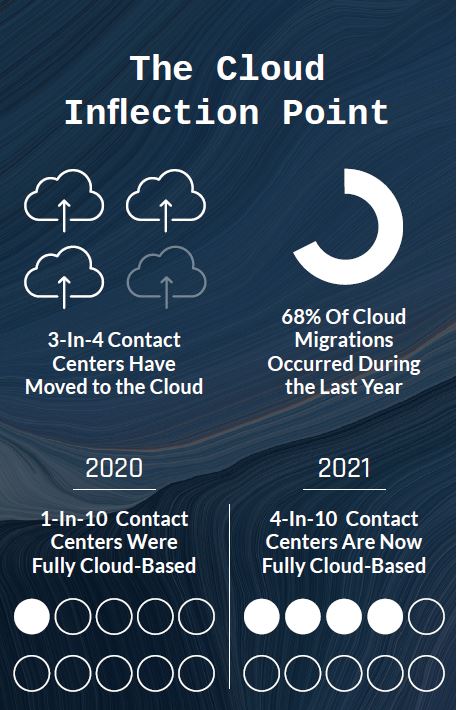
Five years, plus some. That’s the number of years we crammed into 6 months of time, based on how fast contact centers transformed their business strategies and their technology footprints in 2020. Without extensive planning or knowing what was coming, we were all able to look at the impact of the pandemic and figure out how to address the needs of our customers, our employees and our partners. I don’t know about you, but I think we all deserve a toast for the last 12 months.
So, once I had a moment to breathe, I sat back and thought about where we go from here. One of the biggest shifts we saw within our customers was the ready adoption of cloud technology. Some customers were already using cloud platforms in elements of their businesses, but others were not. Regardless of experience, most jumped in the same way – with a level of trust and confidence that you usually don’t see with new technology adoption.
So, cloud is here to stay. But, to find out where we go from here, Calabrio decided to ask the industry. We wanted to learn what managers thought about their expectations of the cloud or experiences of moving to the cloud and if transitioning brought along the benefits that cloud vendors typically tout. We discovered that most contact centers are ready to push further, looking to leverage the inherent agility, flexibility and computing power of the cloud to do even more. In this four-part series, we’ll showcase the input from leaders and what they think comes next in the new Cloud-Smart Era. Read on for our first insight.
Insight #1: The cloud is leading to business value — not just cost-optimization.
Recent waves of cloud migration in the contact center world were largely reactive. Pre-pandemic, organizations were adopting cloud solutions to solve urgent problems — such as achieving greater flexibility and scalability in order to better serve customers, reducing or freeing up CapEx or enabling a foundation for remote workers.
enabling a foundation for remote workers.
Managers knew they needed to be in the cloud, but many had yet to develop a strategic roadmap of how to get there or what to do when they got there. While the pandemic quickly propelled contact centers to the cloud, now is the time to move out of this reactive phase and into the next. In fact, 75% of contact centers now recognize that being in the cloud isn’t just a cost-efficiency or flexibility play — it enables them to be more strategic and make smarter business decisions.
All the well-established benefits around operational efficiency are still on the table, but they’ve increasingly become table stakes for modern, forward-thinking contact centers. Now, contact center leaders are looking first at what they want to achieve — targeted customer experience enhancements, integrating voice-of the-customer (VOC) analytics across the business or improving agent engagement, and building cloud-powered solutions and workflows around those strategic priorities. This is a more proactive approach to cloud adoption, making it easier to sell the transition to new cloud-enabled applications in the future to others in the organization.
More than three out of four contact centers have already made full or partial moves to the cloud. But, an astounding 68% of those cloud migrations happened over the last year during the pandemic. After all of this activity, a quarter of contact centers are now fully cloud-based — a substantial jump from less than a year ago, when a Calabrio 2020 survey found just 1 in 10 had fully moved to the cloud. It is those contact centers that are achieving the greatest strategic impact on the business and are looking toward the next phase of cloud adoption.
So, what is the next phase? Come back for Part 2 next week and we’ll discuss how adding artificial intelligence and machine learning into cloud environments has become much simpler due to modern advancements in cloud structure.
Edited by
Erik Linask